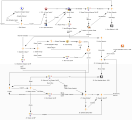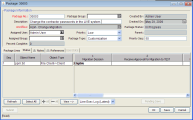OpenText Application Quality Management - Request For Change Workflow
The OpenText Application Quality Management - Request For Change workflow is the sequence of approvals, decisions, or actions by which the RFC is processed. The RFC starts at the beginning of the workflow. When the RFC reaches the end of the workflow, its lifecycle is complete.
Upon creation, an OpenText Application Quality Management - Request For Change (RFC) request is automatically set to use the OpenText Application Quality Management - Request For Change workflow.
Figure 3-3 shows the workflow. Table 3-3 lists the important steps in the workflow and the user roles associated with those steps.
|
Step |
User Security |
Description |
|---|---|---|
|
1. Filter Request |
OpenText Application Quality Management - Change Manager |
Perform initial review and classification of the change request, and determine if this RFC is acceptable based on company policy. |
|
4. SOX - In Scope System? |
Fully automated step |
SOX requires identification of key systems related to accurate financial reporting, directly or indirectly. This field is automatically determined based on the system selected. |
|
3. SOX - Impact Assessment |
OpenText Application Quality Management - SOX - System Owner |
SOX requires additional impact assessment for any change that could affect financial reporting. The impact of not doing the change must be considered as well. |
|
6. Allocate Priority |
OpenText Application Quality Management - Change Manager |
Validate RFC priority and determine if this is an Urgent Change request. |
|
5. Urgent/Emergency Changes |
(None) |
Call a subworkflow designed to handle urgent or emergency changes, described in OpenText Application Quality Management - RFC - Urgent Change Management Sub WF Subworkflow. |
|
9. Change Review and Approval Sub WF |
OpenText Application Quality Management - Change Manager |
Call a subworkflow to manage the review and approval process for the RFC, described in OpenText Application Quality Management - Change Review and Approval Sub WF Subworkflow. (This subworkflow can, in turn, call the OpenText Application Quality Management - Impact & Resource Assessment Sub WF subworkflow.) |
|
7. Authorize & Schedule Change |
OpenText Application Quality Management - Change Manager |
Authorize the change request and schedule change for implementation. |
|
11. Application Change? |
OpenText Application Quality Management - Change Manager |
Determine if this is an application change. |
|
13. Infrastructure Changes Sub WF |
(None) |
Call a subworkflow to handle non-application changes, described in OpenText Application Quality Management - Infrastructure Changes Sub WF Subworkflow. |
|
12. Detailed Design |
OpenText Application Quality Management - Application Developer |
Create functional and design specification documents. |
|
14. Build Application Change |
OpenText Application Quality Management - Application Developer |
Build application code for the change. |
|
15. Create Package |
OpenText Application Quality Management - Application Developer |
Create a package with the code changes. This step automatically creates a package and adds the package as a reference to the RFC request. OpenText Application Quality Management - Request For Change Workflow illustrates a typical RFC package. |
|
17. Plan Tests Sub WF |
(None) |
Call a subworkflow to manage the test planning process for the RFC, described in OpenText Application Quality Management - Plan Tests Sub WF Subworkflow. |
|
20. Build |
OpenText Application Quality Management - Change Builder |
Build the change, in preparation for implementation. For an application change, add code components to the referenced package in the PPM Workbench (see the Create Package step). |
|
21. Release Decision |
OpenText Application Quality Management- Change Builder |
Select the option to implement this application change as part of a release or independently. |
|
22. Deploy and Test Changes Sub WF |
(None) |
Call a subworkflow for deploying and testing changes, described in OpenText Application Quality Management - Deploy and Test Changes Sub WF Subworkflow. |
|
23. Non Release Sub WF |
(None) |
Call a subworkflow for change deployment not involving a release, described in OpenText Application Quality Management - Non Release Sub WF Subworkflow. |
|
24. Release Sub WF |
(None) |
Call a subworkflow for change deployment involving a release, described in OpenText Application Quality Management - Release Sub WF Subworkflow. |
|
25. Change Working? |
OpenText Application Quality Management - Change Manager |
Review whether the change was successfully implemented with no adverse impact. |
|
26. Implement Backout Plans |
OpenText Application Quality Management - Operations Manager |
If the change is not working, implement backout plans to back out the change from the LIVE environment. |
|
27. Requestor Sign-Off |
OpenText Application Quality Management - Change Manager |
Get sign-off from the requestor of the change to acknowledge that the change was implemented. |
|
28. Post Implementation Review |
OpenText Application Quality Management - Change Manager |
Review the change after implementation to determine whether the change process was followed correctly. |
|
29. Close (Immediate Success) - 100% |
(None) |
Update status to Closed. |
Step 15 in the OpenText Application Quality Management - Request for Change workflow creates a package to deploy and test changes, and the step adds the package as a reference to the RFC request. This package requires specifying a workflow, and the default is the OpenText Application Quality Management - Change Migration workflow, as shown in the example in Figure 3-4. Step 22 in the OpenText Application Quality Management - Request for Change workflow calls the OpenText Application Quality Management - Deploy and Test Changes Sub WF subworkflow to deploy and test the package.









